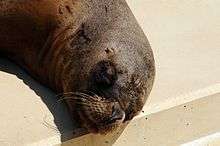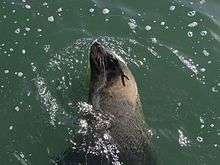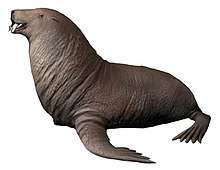Eared seal
An eared seal or otariid or otary is any member of the marine mammal family Otariidae, one of three groupings of pinnipeds. They comprise 15 extant species in seven genera (another species became extinct in the 1950s) and are commonly known either as sea lions or fur seals, distinct from true seals (phocids) and the walrus (odobenids). Otariids are adapted to a semiaquatic lifestyle, feeding and migrating in the water, but breeding and resting on land or ice. They reside in subpolar, temperate, and equatorial waters throughout the Pacific and Southern Oceans and the southern Indian and Atlantic Oceans. They are conspicuously absent in the north Atlantic.
| Eared seals | |
|---|---|
| An Australian sea lion (Neophoca cinerea) | |
| Scientific classification | |
| Kingdom: | Animalia |
| Phylum: | Chordata |
| Class: | Mammalia |
| Order: | Carnivora |
| Clade: | Pinnipediformes |
| Clade: | Pinnipedia |
| Clade: | Panotariidae |
| Family: | Otariidae Gray, 1825 |
| Type species | |
| Otaria flavescens (Shaw, 1800) | |
| Genera | |
|
Arctocephalus | |
The words 'otariid' and 'otary' come from the Greek otarion meaning "little ear",[2] referring to the small but visible external ear flaps (pinnae), which distinguishes them from the phocids.

Evolution and taxonomy
| |||||||||||||||||||||||||||||||||||||||||||||||||||||||||||||||||||||||||||||||||||||||||||||
| Cladogram showing the eared seals, Otariidae, and their relationships with other pinnipeds, combining several phylogenetic analyses.[3] |
Along with the Phocidae and Odobenidae, the two other members of Pinnipedia, Otаriidae are descended from a common ancestor most closely related to modern bears.[4] Debate remains as to whether the phocids diverged from the otariids before or after the walrus.
Otariids arose in the Miocene (15-17 million years ago) in the North Pacific, diversifying rapidly into the Southern Hemisphere, where most species now live. The earliest known fossil osariid [sic] is Eotaria crypta from southern California,[1] while the genus Callorhinus (northern fur seal) has the oldest fossil record of any living otariid, extending to the middle Pliocene. It probably arose from the extinct fur seal genus Thalassoleon.
Traditionally, otariids had been subdivided into the fur seal (Arctocephalinae) and sea lion (Otariinae) subfamilies, with the major distinction between them being the presence of a thick underfur layer in the former. Under this categorization, the fur seals comprised two genera: Callorhinus in the North Pacific with a single representative, the northern fur seal (C. ursinus), and eight species in the Southern Hemisphere under the genus Arctocephalus; while the sea lions comprise five species under five genera.[5] Recent analyses of the genetic evidence suggests that Callorhinus ursinus is in fact more closely related to several sea lion species.[6] Furthermore, many of the Otariinae appear to be more phylogenetically distinct than previously assumed; for example, the Japanese sea lion (Zalophus japonicus) is now considered a separate species, rather than a subspecies of the California sea lion (Zalophus californius). In light of this evidence, the subfamily separation has been removed entirely and the family Otariidae has been organized into seven genera with 16 species and two subspecies.[7][8] Nonetheless, because of morphological and behavioral similarities among the "fur seals" and "sea lions", these remain useful categories when discussing differences between groups of species. Compared to sea lions, fur seals are generally smaller, exhibit greater sexual dimorphism, eat smaller prey and go on longer foraging trips; and, of course, there is the contrast between the coarse short sea lion hair and the fur seal's fur.
Anatomy and appearance

Otariids have proportionately much larger foreflippers and pectoral muscles than phocids, and have the ability to turn their hind limbs forward and walk on all fours, making them far more maneuverable on land. They are generally considered to be less adapted to an aquatic lifestyle, since they breed primarily on land and haul out more frequently than true seals. However, they can attain higher bursts of speed and have greater maneuverability in the water. Their swimming power derives from the use of flippers more so than the sinuous whole-body movements typical of phocids and walruses.
Otariids are further distinguished by a more dog-like head, sharp, well-developed canines, and the aforementioned visible external pinnae. Their postcanine teeth are generally simple and conical in shape. The dental formula for eared seals is: 3.1.4.1-32.1.4.1. Sea lions are covered with coarse guard hairs, while fur seals have a thick underfur, which has historically made them the objects of commercial exploitation.
Male otariids range in size from the 70-kg (150-lb) Galápagos fur seal, smallest of all pinnipeds, to the over 1,000-kg (2,200-lb) Steller sea lion. Mature male otariids weigh two to six times as much as females, with proportionately larger heads, necks, and chests, making them the most sexually dimorphic of all mammals.[9]
Behavior
All otariids breed on land during well-defined breeding seasons. Except for the Australian sea lion, which has an atypical 17.5 month breeding cycle, they form strictly annual aggregations on beaches or rocky substrates, often on islands. All species are polygynous; i.e. successful males breed with several females. In most species, males arrive at breeding sites first and establish and maintain territories through vocal and visual displays and occasional fighting. Females typically arrive on shore a day or so before giving birth. While considered social animals, no permanent hierarchies or statuses are established on the colonies. The extent to which males control females or territories varies between species. Thus, the northern fur seal and the South American sea lion tend to herd specific harem-associated females, occasionally injuring them, while the Steller sea lion and the New Zealand sea lion control spatial territories, but do not generally interfere with the movement of the females.
Otariids are carnivorous, feeding on fish, squid and krill. Sea lions tend to feed closer to shore in upwelling zones, feeding on larger fish, while the smaller fur seals tend to take longer, offshore foraging trips and can subsist on large numbers of smaller prey items. They are visual feeders. Some females are capable of dives of up to 400 m (1,300 ft).
Species
Family Otariidae
- Subfamily Arctocephalinae (fur seals)
- Genus Arctocephalus
- Antarctic fur seal, A. gazella
- Guadalupe fur seal, A. townsendi
- Juan Fernández fur seal, A. philippii
- Galápagos fur seal, A. galapagoensis
- Brown fur seal, A. pusillus
- South African fur seal, A. pusillus pusillus
- Australian fur seal, A. pusillus doriferus
- New Zealand fur seal (or southern fur seal), A. forsteri
- Subantarctic fur seal, A. tropicalis
- South American fur seal, A. australis
- Genus Callorhinus
- Northern fur seal, C. ursinus
- Genus Arctocephalus
- Subfamily Otariinae (sea lions)
- Genus Eumetopias
- Steller sea lion, E. jubatus
- Genus Neophoca
- Australian sea lion, N. cinerea
- Genus Otaria
- South American sea lion, O. flavescens
- Genus Phocarctos
- New Zealand sea lion (or Hooker's sea lion), P. hookeri
- Genus Zalophus
- California sea lion, Z. californianus
- †Japanese sea lion, Z. japonicus - extinct (1970s)[10][11]
- Galápagos sea lion, Z. wollebaeki
- Genus Eumetopias
Although the two subfamilies of otariids, the Otariinae (sea lions) and Arctocephalinae (fur seals), are still widely used, recent molecular studies have demonstrated that they may be invalid.[12][13] Instead, they suggest three clades within the family; one consisting of the northern sea lions (Eumetopias and Zalophus), one of the northern fur seal (Callorhinus) and its extinct relatives, and the third of all the remaining Southern Hemisphere species.[14]
References
- Boessenecker, R. W.; Churchill, M. (2015). "The oldest known fur seal". Biology Letters. 11 (2): 20140835. doi:10.1098/rsbl.2014.0835. PMC 4360102. PMID 25672999.
- "Otary, n., etymology of" The Oxford English Dictionary. 2nd ed. 1989. OED Online. Oxford University Press. http://dictionary.oed.com/ Accessed November 2007
- Berta, A.; Churchill, M. (2012). "Pinniped taxonomy: Review of currently recognized species and subspecies, and evidence used for their description". Mammal Review. 42 (3): 207–34. doi:10.1111/j.1365-2907.2011.00193.x.
- Lento, G.M.; Hickson, R.E.; Chambers, G.K.; Penny, D. (1 January 1995). "Use of spectral analysis to test hypotheses on the origin of pinnipeds". Molecular Biology and Evolution. 12 (1): 28–52. doi:10.1093/oxfordjournals.molbev.a040189. PMID 7877495.
- J.E. King (1983). Seals of the World (2nd ed.). New York: Cornell University Press. ISBN 978-0-7022-1694-7.
- Wynen, L; Goldsworthy, SD; Insley, SJ; Adams, M; Bickham, JW; Francis, J; Gallo, JP; Hoelzel, AR; et al. (2001). "Phylogenetic relationships within the eared seals (Otariidae: Carnivora): implications for the historical biogeography of the family". Mol. Phylogenet. Evol. 21 (2): 270–284. doi:10.1006/mpev.2001.1012. PMID 11697921.
- Brunner, S. (2003). "Fur seals and sea lions (Otariidae): identification of species and taxonomic review". Systematics and Biodiversity. 1 (3): 339–439. doi:10.1017/S147720000300121X.
- "Otariidae". Integrated Taxonomic Information System. Retrieved November 2007. Check date values in:
|accessdate=(help) - Weckerly, FW (1998). "Sexual-size dimorphism: influence of mass and mating systems in the most dimorphic mammals". Journal of Mammalogy. 79 (1): 33–42. doi:10.2307/1382840. JSTOR 1382840.
- Aurioles, D. & Trillmich, F. (IUCN SSC Pinniped Specialist Group) (2008). "Zalophus japonicus". IUCN Red List of Threatened Species. 2008. Retrieved 7 January 2009.CS1 maint: ref=harv (link)
- (in Japanese) Zalophus californianus japonicus (CR), Red Data Book, Japan Integrated Biodiversity Information System, Ministry of the Environment (Japan). "The Japanese sea lion (Zalophus californianus japonicus) was common in the past around the coast of the Japanese Archipelago, but declined rapidly after the 1930s from overhunting and increased competition with commercial fisheries. The last record in Japan was a juvenile, captured in 1974 off the coast of Rebun Island, northern Hokkaido."
- Yonezawa, T.; et al. (2009). "The monophyletic origin of sea lions and fur seals (Carnivora; Otariidae) in the Southern Hemisphere". Gene. 441 (1–2): 89–99. doi:10.1016/j.gene.2009.01.022. PMID 19254754.
- Arnason, U.; et al. (2006). "Pinniped phylogeny and a new hypothesis for their origin and dispersal". Molecular Phylogenetics and Evolution. 41 (2): 345–354. doi:10.1016/j.ympev.2006.05.022. PMID 16815048.
- Berta, A.; Churchill, M. (2012). "Pinniped Taxonomy: evidence for species and subspecies". Mammal Review. 42 (3): 207–234. doi:10.1111/j.1365-2907.2011.00193.x.
Further reading
- Berta, A., and L. Sumich (1999) Marine Mammals: Evolutionary Biology. San Diego: Academic Press.
- Gentry, R. L (1998) Behavior and Ecology of the Northern Fur Seal. Princeton: Princeton University Press.
- Perrin, W. F., B. Würsig, and J. G. M. Thewissen (2002) Encyclopedia of Marine Mammals. San Diego: Academic Press.
- Riedman, M. (1990) The Pinnipeds: Seals, Sea Lions and Walruses. Berkeley: University of California Press.

